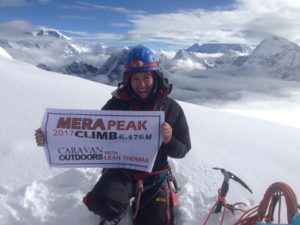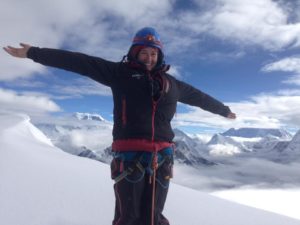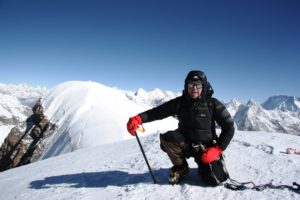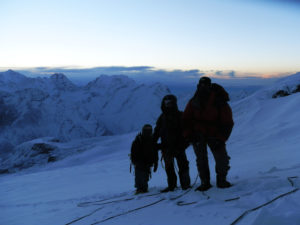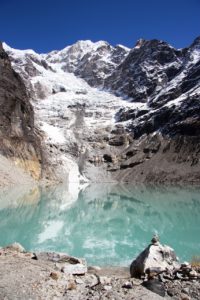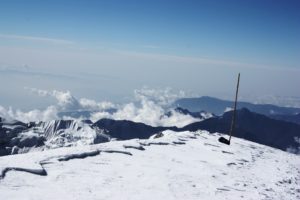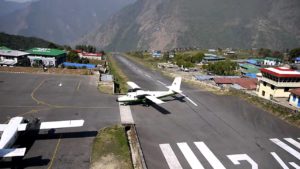Mera Peak Climbing – 17 Days
The ultimate trekking peak in Nepal is Mera Peak climbing. Standing at an altitude of 6476m among other elegant Himalayan mountains in the Khumbu region, it has been the most glorious and desired trekking peak since before conquering Mt Everest in 1953. This highest trekking peak was actually conquered just nine days before reaching the human being at top of the Mt Everest. Since then, millions’ of people have already had the aesthetic pleasure of mind-blowing postcard scenes of Khumbu region by summiting Mera Peak. It delights the climbers with magnificent crystal clear views of Mt. Everest (8848m), Cho- Oyu (8210m), Lhotse(8516m), Makalu(8463m), Kanchenjunga(8586m), Nuptse(7855m), Chamlang(7319m), Baruntse(7129m), Ama Dablam(6812m), Kangtega(6779m) and many more.
Mera Peak Climbing begins with a flight from Kathmandu to Lukla for a few minutes. The trekking commences from Lukla with multiple choices of routes: North side, South side, or West side. Whichever is chosen the place can be reached through the amazing Hinku valley where climbers can enjoy pristine nature as well as Sherpa villages, their culture, beautiful monasteries, suspension bridges, narrow wooden bridges, rhododendron, and pine forest. Similarly, they can feel being close to nature while trekking on the rough terrains, and also feel an amazing mixture of excitement, thrill, and danger while moving up along with glaciers, and crevasses. Mera Peak climbing is quite challenging for novice climbers. And a lack of proper acclimatization, extremely cold weather, dry winds, and a long summit day can make their trekking more challenging. However, some skills and simple training can make climbers easier to reach the summit. During their scaling, they ought to be sure that they are well-acclimatized and have acquired the required knowledge, information, and all equipment and gear. Otherwise, high altitude sickness can kick you hard and you have to terminate your climb. So, climbers should be fit and fine with impressive stamina and endurance. They should follow their guide guidance. The last village on Mera Peak trail is Khare situated at 5045m with a tea house that climbers can reach after 5-7 days of the trek. After a couple of days of acclimatization over 5000m, the actual ascent commences through a rocky and steep trail. From Crampon Points, climbers ought to use gears and move up through icy path following rope lines and escaping crevasses, and after ascent of some hours they can reach the top of Mera Peak and have the marvelous feeling and observation of breathtaking wide snow-capped highest mountains of the Himalayas: Mt Everest, Makalu, Cho Oyu, Lhotse, Nuptse etc. While descending too, trekkers take rest for a while at High Camp before descending to Khare. And following the previous path and enjoying the alluring environment they come back to Lukla, and Lukla to Kathmandu by flight.
As Mera Peak climbing is the highest trekking peak in Nepal, it has been popular in expedition lovers. The spectacular views of glorious gorgeous world’s highest mountains of Himalayas, and the perfect climbing experience for future expedition are its attraction. It’s not just the peak climbing, it is learning in open university of Khumbu Region situated in Solukhumbu district of Province- 1, Nepal.
In short, Caravan Outdoors would like to assure all the trekking and expedition lovers all around the world that we conduct the peak climbing as well as expedition with all safety rules and other required procedure with the most excellent services in reasonable price.
Best Season for Mera Peak Climbing
<p “text-align:justify;”>Despite the fact that enthusiastic mountaineers dare to move up even in the winter, the best seasons for going up Mera Peak are Autumn and Spring.Mera Peak Climbing is the highest trekking peak in Nepal and it takes more than a fortnight to accomplish the mission. In Nepal, till Mid-September there remain slight rainy days. So the rainy season is of course the worst time to climb up. In winter too, due to extreme weather, blizzards and avalanches create hindrances on the path of the climbers. So, in Autumn the sky is clear with mind-blowing visibility, less thick snow in the mountains, and a moderate climate which makes the trekking easy, possible, and memorable. Autumn is categorized into two parts: early Autumn ( Mid Sep- Mid Nov), and late Autumn (Mid-Nov- Mid Jan). Early Autumn is more appropriate than late Autumn from the perspective of time and weather because late Autumn is colder than early Autumn in Nepal. Clouds have gone, days are sunny, and horizons have the strongest visibility, even many mountains are visible from Kathmandu Valley in Autumn.
Another best time is Spring ( Mid March to Mid May). This time is the best because Spring prospers the whole environment of the Hinku Valley with greenery, blooming rhododendron, and superb bio-diversity. A great combination of a blooming environment with a moderate climate really fascinates the trekkers. The mountaineers who admire nature, culture, and high snow-capped mountains, Spring is the best time for them to accomplish Mera Peak Climbing, the highest peak trekking situated at an altitude of 6476m from where they can have a close look at the magnificent highest mountains in the world. Actually, these seasons are not only the best seasons for Mera Peak Climbing but also the best for all mountaineering and expeditions.
Equipments required for Mera Peak Climbing
Since Mera Peak is the highest trekking peak in Nepal and gives the vibes of an expedition, it requires a lot of precautions and preparation. Wise climbers ought to have all the equipment and gear to accomplish Mera Peak Climbing. Here is the list of those things which are essential for reaching the summit of Mera Peak.
Climbing Boots: Climbing boots make it easier for mountaineers to climb up the mountains. The spiky soles of the boots prevent the climbers from slipping on the rocky and snowy routes and keep them warm. So, for a comfortable and safe climb Climbing Boots are essential for Mera peak climbing.
Crampons: It is a traction device attached to footwear to improve climbing the snowy routes of mountains. The more the climbers go up the more the paths become snowy. They have to go through the glaciers and crevasses, and the grips on the crampons enable them to be stable and walk through such dangerous paths. Thus, crampons are one of the most required objects during peak climbing.
Descender: It is also a device that helps to be stable or fix oneself at a particular position on the rope. It is designed to help regulate friction and control the descent on a fixed rope.
Ascender: It is also a device that helps to climb up and provides protection with a fixed rope during the climb up steep mountains.
Screw Gale/ Carabiner/ Karabiner: This is a D- shape mental clip that allows mountaineers to link together ropes and harnesses.
Ice-Axe: This tool is used for climbing up steep mountains covered by snow. It looks like an Axe but doesn’t have a sharp thick blade on the edge, but has a sharp point that easily goes into the ice and helps climbers to come up holding it.
Helmet- UIAA Test: While climbing up the steep mountains sometimes broken pieces of rocks may fall down which can cause a fatal accident. So, to avoid dreadful harm, Helmets that pass the test of UIAA should be used.
Harness: For a successful climb up any mountain above 5000 m harness is essential. It helps climbers connect to the rope and saves them from falling and sliding. A full body harness or seat harness is the most required object for climbing mountains.
Meals and Accomodation for Mera Peak Climbing
To achieve anything, a healthy body is essential, and the body gets energy from the food we intake. The mountains of the Himalayas have a mental association with extremely cold weather. But, till the actual trekking or expedition starts, the mountaineers have to go through the insanely beautiful well facilitated hotels, lodges, and restaurants where they can stay, have their breakfast, lunch, dinner, tea, coffee many other facilities like taking shower, electric blanket for which they have to pay extra.
Mera Peak Climbing and Island peak climbing goes on for more than a fortnight. So, trekkers can have their lunch and dinner at the hotels where they stay. Basically, they are offered Nepali National food: Dal ( lentil soup), bhat( rice), tarkari ( vegetables), saag ( green vegetable), achar ( pickle) at dinner. This meal is a balanced diet from which trekkers can get carbohydrates, proteins, vitamins, fat, fiber, minerals, etc. Similarly, trekkers can have different foods that are normally available in restaurants either veg or non-veg. Likewise, many other things like soft drinks and hard drinks, soups, and fruits which are beneficial for health and acclimatization are also available in Khumbu Region. Just the matter is that they are more expensive than in Kathmandu. Because maximum food items, drinks, and other essential requirements have to be supplied from Kathmandu by plane. And the food tests are different than in Kathmandu valley.
For sleeping, they have a cozy room with hot blankets, thick mattresses, and internet access. In a room, there are two separate beds. If the trekkers need an additional blanket or electric blanket or hot water for taking bath, they have to pay extra for them. Khare is the last village where you can get a tea house. Khare ( 5413m)is also the base camp for Mera Peak climbing. When you move to the Peak and reach the High camp(5800m) there, a tent is set up and food is prepared by the crew members. After taking a meal and resting, they climb up to the summit. When they descend, the same previous routine of rest, walking, food, and accommodation they repeat.
Note: Keep a grace day to ensure you climb the summit even if you fail to do so the first day because of bad weather.
Trip Difficulty: Challenging
Requires prior experience of high-altitude trekking. The altitude may get over 6000 m and may require some climbing skills, such as; cramponing, ice-axing etc.
Service Level: Standard
Comfortable tourist-class accommodations with character; mix of public and private transport. Star Standard meals at Kathmandu!
| Day 1 | Arrive in Kathmandu/Transfer to Hotel | – |
| Day 2 | Rest Day/Trek preparation | – |
| Day 3 | Fly to Lukla and Trek to Chutenga 3,430 m | 3-4 hours |
| Day 4 | Trek to Thuli Kharka 4,000 m | 5-6 ours |
| Day 5 | Trek to Mausam Kharka 3.430 m | 3-4 hours |
| Day 6 | Trek to Tangnang 4,360 m | 5-6 hours |
| Day 7 | Acclimatization at Tangnag | – |
| Day 8 | Trek to Khare 5,000 m | 4-5 hours |
| Day 9 | Acclimatization at Khare | – |
| Day 10 | Trek to Mera High Camp 5,800 m | 5-6 hours |
| Day 11 | Summit Mera Peak 6,476 m & Return to Lower Base Camp | 7 hours |
| Day 12 | Spare day for Additional attempt | – |
| Day 13 | Trek to Gothey 3,600 m | 4-5 hours |
| Day 14 | Trek to Thuli Kharka 4,250 m | 4 hours |
| Day 15 | Trek to Lukla via Zatwar La Pass 4,600 m | 5-6 |
| Day 16 | Fly to Kathmandu | – |
| Day 17 | Depart from Kathmandu | – |
Includes
- Arrival airport pick and drop.
- Dinner in one of the finest diners in Kathmandu before and after the trek.
- 3 Nights at ★★★ hotel in Kathmandu.
- Entire land commute during the trip
- Domestic flight fare, airport tax and domestic transfer.
- Standard Tea-house/ Lodge during the trek.
- (B,L,D) Meals during the trek.
- 1 Climbing Guide (Licensed & First Aid Trained), 1 Assistant Guide and 2 Porters
- Mountain climbing and other related permits
- Personal High-altitude Tents
- Kitchen equipment, cook and staff
- Duffel Bag
- Climbers’ Certificate (Issued by Government)
- Arrangement of Rescue/Medical Helicopter service; covered by your Insurance agency.
Excludes
- Visa & Processing Fee
- International flight fares
- Meals other than during the trek and before/after complimentary dinner
- Mineral water and refreshments during the trek
- Personal gears and equipment
- Travel insurance (Cover Helicopter evacuation and Trip Cancellation charges)
- Guide/Porter Tipping
Group Climbing Gear- We Provide
- Rope, Harness, Ice-axe, Carabineers, Crampons
- F-8, Jumper, Helmet, Ice-Bar, and Ice-screw, Climbing permit
- Tent, foam mattress, sleeping bags, PAC
Testimonials
I had never done anything like this before, climbing a peak […] I summitted Mera Peak (6400+ meters) which I had my doubts on doing since I was coming directly from sea level, but was able to do it with no major problems! It was a great experience, the guides were amazing, the trip was amazing! ~Leah Thomas (USA)
Additional information
The above information is a guide and standard template of what we provide. Our trip can be customized at your request to accommodate your specific requirements.
Responsible Tourism
Currently, we help raise fund and donate it to help build schools and shelters at the Earthquake stricken regions of Central Nepal province. You can join the cause help donate or volunteer to teach at the primary level schools. Visit Community Center for more information.
- Arrival in Kathmandu At your arrival in Kathmandu, a member of our team will greet and receive you at the airport. You will be transferred to your hotel. Our representative will brief on your arrival about the trip. The rest of the day is yours. The evening we be spent enjoying complimentary local dinner one of the finest local diner with cultural program.
- Rest Day/Trek Preparation Today is the rest day. You can spend time relaxing, acclimatizing and preparing for the trek.
- Fly to Lukla & Trek to Chutenga Today you will fly to Lukla. It takes a little more than 35 minutes to reach the Lukla Airport. The first day of trek is get you warmed up for the upcoming days. The trail ascends to the village of Chutenga on the eastern side of Lukla.
- Trek to Thuli Kharka You start by hiking uphill to reach Zatrwaog. The route leads directly to the Zatrwa La at 4,600 m. The trail descends an hour taking you to Thuli Kharka.
- Trek to Mausam Kharka Today, you trek for about five hours to reach the Mausam Kharka. The path is uneven and leads through the Hinku valley. The trail further descends through forest with rhododendron, fir and pine trees. And reaches towards Mausam Kharka.
- Trek to Tangnang You hike northwards along the west bank of the Hinku Drangka River. The trail is populated area, and you may find many villages and settlesments en route. Upon crossing the villages you arrive at Gondishung which lies at an altitude of 4,350 m. Gondishung has a 200 years old monastery (gompa) beneath rock overhang. You will call it a day after reaching Tangnang.
- Acclimatization Day You spend the day acclimatizing at Tangnang or making a short hike upwards.
- Trek to Khare This leg of trek is fairly easy and you can enjoy more time relishing the sceneries of the surrounding peaks. After some walking and crossing a stream, the trail will lead you to Khare.
- Acclimatization Day You spend the day acclimatizing at Khare or making a short hike upwards.
- Trek to Mera High Camp The day starts with climbing a riff, and then follow the crest of the steep slope along a zigzag path right to the top. The route leads to the lower tongue of the Mera Glacier in less than two hours. Here you prepare your crampons to climb the 30-35 degree acclivity layered by ice and snow. There are well marked trails unless in case of fresh snowfall. You walk along the weaving path to reach Mera La and continue fopr couple of hours to reach the high camp and rest for the night.
- Mera Peak Summit & Return to the Base Camp It’s a Big Day! You start early, basically before before the dawn (2am -5 am). It can take up to six hours to reach the summit. To plain eye, the distance from the camp site to the summit looks very near, however, it’s a long climb up the ridge. Your goal is to reach the summit before the midday and return to lower base camp.
- Spare Summit Attempt A spare day is kept if you miss the summit the day before. It’s essential that you wait if the weather condition worsens. Keeping an extra day will ensures you can summit the peak one way or another.
- Trek to Gothey You descend down the Hinku valey to stay overnight at Gothey. It’s a short hike. You can spend the day throwing a small party.
- Trek to Thuli Kharka You head to Thuli Kharka leaving Gothey. It’s entirely a downhill hike.
- Trek to Lukla via Zatwar La Pass The final leg of the trip passes through Zatrwala pass and concedes at Lukla.
- Fly back to Kathmandu You can take the earliest possible flight back to Kathmandu. One of our representative will transfer you to your hotel. Later the evening, we will treat you with a complimentary dinner, a set of exquisite Nepalese cuisines.
- Departure from Kathmandu You will be transferred to the Airport to catch your flight back home.
-
Package Price Date
Mera Peak Climbing – 17 Days
Get this trip at $ 2299USDTrips Details
| Trip Length | 17 days | |
| Climb Length | 02 days | |
| Activities | Trekking, Climbing | |
| Max. Altitude | 6,476 meters (21,240 ft) | |
| Trek Style | Tea-house (Lodges), Camping | |
| Meal | Full board on trip | |
| Accommodation |
|
|
| Transportation | Private Vehicle, Domestic Flight | |
| Best Month | February, March, April, May, September, October, November | |
| Required (Min) | 2 Person |
- Guaranteed Departure
- Bigger Group, Bigger Discount
- Customizable Trips
- All Inclusive/GAP Trip Available
Send your inquiry via the form below
